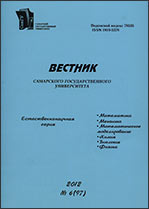|
Mechanics
Use of the indirect boundary elements method for isotropic plates on an elastic Winkler base and Pasternak — Vlasov base
P. G. Velikanova, N. I. Kukanovb, D. M. Khalitovaa
a Kazan (Volga Region) Federal University, Kazan, Russian Federation
b Ulyanovsk State Technical University, Ulyanovsk, Russian Federation
(published under the terms of the Creative Commons Attribution 4.0 International License)
Abstract:
The calculation tasks combining lightness, economy, high strength and reliability of thin-walled structures on an elastic base are relevant for modern mechanical engineering. In this regard, the use of isotropic materials on an elastic base seems justified, therefore their calculation is considered in this article. The problems of the theory of plates and shells belong to the class of boundary value problems, the analytical solution of which, due to various circumstances (the nonlinearity of differential equations, the complexity of geometry and boundary conditions, etc.), cannot be determined. Numerical methods help to solve this problem. Among numerical methods, undeservedly little attention is paid to the boundary element method. In this regard, the further development of indirect compensating loads method for solving problems of the theory of isotropic plates on an elastic base of Winkler and Pasternak — Vlasov, based on the application of exact fundamental solutions, is relevant.
Keywords:
mechanics, mathematics, differential equations, plates on an elastic base of Winkler and Pasternak — Vlasov, fundamental solutions, influence functions, indirect boundary elements method, compensating loads method.
Received: 26.02.2021
Revised: 30.03.2021
Accepted: 28.05.2021
Citation:
P. G. Velikanov, N. I. Kukanov, D. M. Khalitova, “Use of the indirect boundary elements method for isotropic plates on an elastic Winkler base and Pasternak — Vlasov base”, Vestnik SamU. Estestvenno-Nauchnaya Ser., 27:2 (2021), 33–47
Linking options:
https://www.mathnet.ru/eng/vsgu654 https://www.mathnet.ru/eng/vsgu/v27/i2/p33
|

| Statistics & downloads: |
| Abstract page: | 93 | | Full-text PDF : | 28 | | References: | 27 |
|




 Contact us:
Contact us: Terms of Use
Terms of Use
 Registration to the website
Registration to the website Logotypes
Logotypes









 Citation in format
Citation in format 